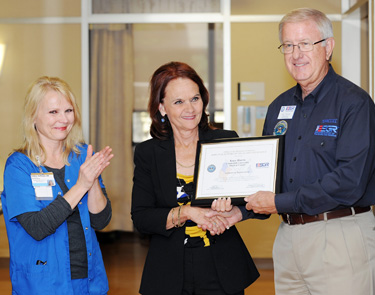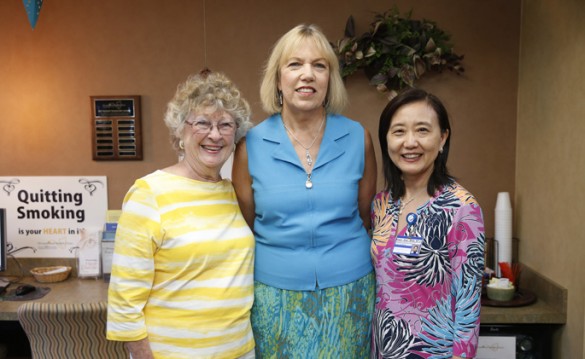
by Meredith Jackson
Complications related to opioid abuse occur in 54,000 pregnancies annually in the United States, and Tennessee ranks among the top 10 states in the number of opioid-dependent pregnant women.
To address this challenge, board-certified nurses Jana Briggs, R.N., and Lori Harris, R.N., from Vanderbilt Psychiatric Hospital (VPH) and Mindy Sacco, R.N., from Vanderbilt University Adult Hospital’s Labor and Delivery Unit recently forged a unique collaboration.
Their goal was to increase use of a stabilization protocol that improves outcomes for opiate-dependent pregnant women and their babies.
An elaborate poster documenting their efforts won a first-place award last fall at the annual conference of the American Psychiatric Nurses Association in Hartford, Connecticut.
The project began when Briggs, Harris and Sacco served on an addictions steering committee and noticed a surge in opiate-dependent pregnant women coming to Vanderbilt for help.
The influx was related both to a rise in opioid use nationwide as well as a change in legislation in Tennessee that made it a criminal offense if mothers of drug dependent newborns were not receiving treatment.
Opiate addiction during pregnancy places the mother and her child at risk of serious complications, including neonatal abstinence syndrome (NAS).
“Infants may have withdrawal symptoms,” Sacco said. “They have problems feeding, growing and bonding along with other challenges. Babies with NAS frequently require long, costly stays in the neonatal intensive care unit.”
A few years earlier, Vanderbilt psychiatrist and addiction specialist Peter Martin, M.D., was a leader in a national study that compared the effectiveness of methadone versus subutex (buprenorphine) for stabilizing a pregnant woman and her fetus dependent on opiates.
The study found that infants born to women who were stable on subutex during their pregnancy required less morphine to treat NAS and fewer days in the hospital and suffered milder symptoms.
“Withdrawals aren’t as severe with subutex,” Briggs said. “The goals of treatment are for the women not to relapse and for their babies to be born with minimal withdrawal symptoms.”
While VPH had adopted the subutex protocol, Briggs, Harris and Sacco noticed that Labor and Delivery did not have a standardized approach. So they created a specific protocol for pregnant women based on Martin’s research and draft protocols. They followed that with a series of training sessions at both hospitals.
The training included workshops, presentations at grand rounds and one-on-one shadowing of VPH nurses.
Briggs, Harris and Sacco also uploaded the new protocol to the Vanderbilt e-docs system and printed out “cheat sheets” nurses could pin to the back of their name badges.
As the protocol was applied more widely, use of full opiates for stabilization during pregnancy dropped, patients were stabilized more quickly and fewer of them left the hospital against medical advice.
“There’s less frustration among patients,” Briggs said.
The focus on improving outcomes for mothers and babies also reduced the stigma of opiate addiction overall. “These women have experienced challenges in their life,” Sacco said. “A lot of them are victims of trauma of some sort, and so it’s really admirable that they’re able to walk in and ask for help.”
Harris said this was the first time VPH nurses had submitted a poster abstract to the national psychiatric nurses meeting that bridged different departments.
“It was really about our collaboration between OB and psych and just wanting to provide the best care for these women from the moment they walked in the door,” Briggs said.
To learn more about the Strategic Directions, go here.















